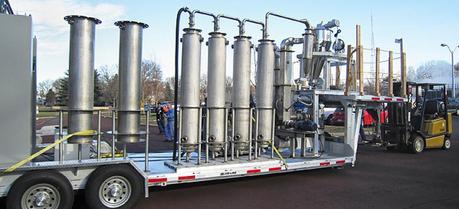 ARS scientists at Wyndmoor, Pennsylvania, are developing this mobile pyrolysis processing system that may one day be used on farms to produce bio-oil. (Credit: Charles Mullen / Agricultural Research Service)
ARS scientists at Wyndmoor, Pennsylvania, are developing this mobile pyrolysis processing system that may one day be used on farms to produce bio-oil. (Credit: Charles Mullen / Agricultural Research Service)Innovations at the U.S. Department of Agriculture (USDA) are bringing researchers one step closer to developing “green” biofuel production systems farmers can use to meet on-farm energy needs, or to produce renewable fuels for commercial markets.
These findings by Agricultural Research Service (ARS) scientists Charles Mullen and Akwasi Boateng promote the USDA priority of finding new bioenergy sources. ARS is USDA’s chief intramural scientific research agency.
Fast pyrolysis is the process of rapidly heating biomass from wood, plants and other carbon-based materials at high temperatures without oxygen. Using pyrolysis to break down tough feedstocks produces three things: biochar, a gas, and bio-oils that are refined to make gasoline.
The bio-oils are high in oxygen, making them acidic and unstable, but the oxygen can be removed by adding catalysts during pyrolysis. Although this adds to production costs and complicates the process, the resulting bio-oil is more suitable for use in existing energy infrastructure systems as a “drop-in” transportation fuel that can be used as a substitute for conventional fuels.
In 2013, the ARS team filed a patent application for a new pyrolysis process called Tail Gas Reactive Pyrolysis (TGRP), which removes much of the oxygen from bio-oils without the need for added catalysts. The team conducted a pilot-scale study using three types of biofeedstock with different characteristics: oak, switchgrass, and pressed pennycress seeds.
The researchers modified the standard pyrolysis process by gradually replacing nitrogen gas in the processing chamber with the gases produced during pyrolysis. The TGRP process was very effective in lowering oxygen levels and acidity, and no additional catalysts were needed.
Bio-oils produced from oak and switchgrass by the new process had considerably higher energy content than those produced by conventional fast pyrolysis. The energy content of the oak bio-oil was 33.3% higher and contained about two-thirds of the energy contained in gasoline. The energy content for switchgrass was 42% higher, slightly less than three-fourths of the energy content of gasoline.
The scientists, who work at the ARS Eastern Regional Research Center in Wyndmoor, Pa., published results from their research in Energy & Fuels (see footnote).
Pourhashem, G., Spatari, S., Boateng, A., McAloon, A., & Mullen, C. (2013). Life Cycle Environmental and Economic Tradeoffs of Using Fast Pyrolysis Products for Power Generation Energy & Fuels, 27 (5), 2578-2587 DOI: 10.1021/ef3016206
